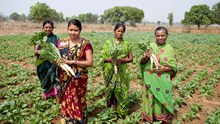
Many mango farmers notice an unusual pattern in their orchards—trees produce a heavy crop one year, followed by little to no yield the next. This phenomenon, known as alternate bearing or biennial bearing, is a natural tendency where the tree alternates between high and low fruit production each year. For commercial mango growers, this inconsistency poses a serious challenge, making it difficult to achieve stable yields and predictable income.
What Causes This Irregularity
Alternate bearing is primarily due to the fact that the tree gets drained after yielding a heavy crop. When this occurs, it targets leaf and shoot development in the coming year, rather than flowering and fruiting. Researchers have established that excessive levels of a growth hormone known as gibberellin during this vegetative stage also inhibit flower bud development.
Moreover, stress results from an imbalance of the carbon-to-nitrogen (C:N) ratio in the tree, which makes it more difficult for the plant to produce flowering consistently. Therefore, during years when the tree invests excessive energy in fruiting or vegetative growth, it is not able to support next-year fruiting.
Selecting the Right Variety for Maximum Yields
Certain mango varieties inherently exhibit reduced alternate bearing. Regular bearers such as Amrapali, Banganapalli, Bangalora, and Neelum are good options if you prefer annual harvests. However, most of these popular varieties in North India tend to exhibit alternate bearing behavior. If you already have them in your orchard, don’t worry you can still manage alternate bearing using the appropriate set of practices to increase fruit yield every year.
Proper Pruning Encourages Fruiting
Mango trees flower normally between February and March, and fruits are picked between June to July.The fruits develop mainly on the shoots that matured last year. This implies that if you prune severely, you may cut off the shoots that would have borne flowers and fruits. Light pruning is preferable. It manages excessive vegetative growth and stimulates the tree to reactivate fruiting buds.
After fruiting, prune lightly to expose the center of the tree. Cut out any dry wood, decaying branches, or cross-crisscrossing branches. By doing so, more sunlight and air will be able to penetrate all sections of the tree, enhancing its health and productivity.
Soil Tillage and Proper Nutrient Application
After pruning, you should then follow up with tilling the soil with the help of a tractor in order to facilitate proper aeration. Use well-rotted farmyard manure, roughly 250 kilograms per tree, in the drip circle around the tree. In addition to this, apply the fertilizers in two split applications.
Generally, monthly, each tree should get 1.5 kilograms of nitrogen, 0.75 kilograms of phosphorus (P2O5), and 1.5 kilograms of potash (K2O). This nutrient mix supports a good balance between growth and bearing. Foliar sprays are also critical.
Spraying the tree with a solution that includes one percent potassium nitrate or one percent potassium dihydrogen phosphate with one percent urea, done three times at monthly intervals. It balances the carbon and nitrogen in the tree, leading to flowering and enhanced fruit set.
Paclobutrazol: A Game-Changer for Flower Induction
One of the new techniques to manage alternate bearing is by employing a plant growth regulator named paclobutrazol. In September and October, it is possible to drench the soil near the tree with paclobutrazol, approximately five grams per plant. After application, water the field right away to enhance its effect.
This chemical lowers the synthesis of gibberellins, the plant growth hormone, and raises levels of cytokinins and chlorophyll. This adjustment allows the tree to store more carbohydrates and stimulates flowering during the next year.
Protecting the Flowers for Improved Fruit Setting
Regardless of whether or not the tree flowers well, flowers must be protected in order to set fruit. Its key danger is the mango hopper, a frequent pest that attacks the flowers in February and March. To manage it, spray the trees twice, after a gap of fifteen days, with insecticides such as Carbaryl (0.25 percent), Diazinon (0.1 percent), or Endosulfan (0.07 percent). Furthermore, monitor for powdery mildew, a fungal infection that may ruin the flowers. Spraying wettable sulphur at 2 grams per litre of water is helpful in controlling this disease.
Alternate bearing is natural in most mango varieties, but with timely care—light pruning, balanced nutrition, growth regulators, pest management, and orchard cleanliness—farmers can regulate yields and boost income. Understanding the tree’s cycle and supporting it ensures better, more predictable harvests and lasting success in mango farming year after year.
















